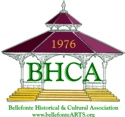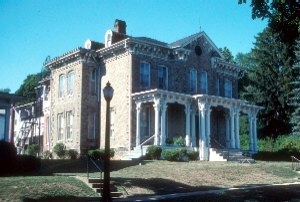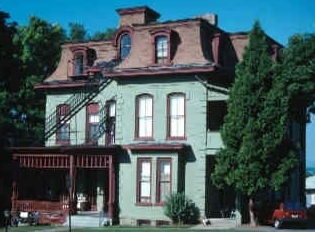 Virtual Walking Tour of Bellefonte, Pennsylvania
Virtual Walking Tour of Bellefonte, PennsylvaniaThe Talleyrand Park Citizens Committee
Bellefonte Historical and Cultural Association
 Virtual Walking Tour of Bellefonte, Pennsylvania
Virtual Walking Tour of Bellefonte, Pennsylvania
The Talleyrand Park Citizens Committee
Bellefonte Historical and Cultural Association
Victorian Styles
BHCA
Home
|
Virtual Tour Home
|
Center Town Map |
Entire Map
The most popular style of architecture prior to the Victorian era was Greek Revival. This style was used almost exclusively for public buildings, where simplicity and dignity were considered the most important attributes. By the 1840s, however, the Greek style was no longer fashionable for a private residence. Its popularity had waned about the time Victoria became Queen (1837). The architecture of the Victorian era was considered to be a new kind of modernism, which is why it had such instant popularity
Gothic Revival (1840-1860)
Most early homes, especially those built in England, were built of stone and enhanced with arches and decorative "stone tracery," elements borrowed from medieval cathedrals. The number of full-blown Gothic stone mansions was never large. Only the wealthy could afford such homes, which required the labors of highly skilled stone carvers. The costly Gothic style was eventually translated into wood, and thousands of Carpenter Gothic houses still stand.
American Carpenter Gothic style is characterized by steeply-pitched roofs, steep gables, and pointed-arch windows. Often the construction was vertical "board and batton" which was considered particularly fitting for a Gothic cottage because of its upward tendency. When Gothic came to America and was translated to Carpenter Gothic, the stone tracery was replaced by wooden gingerbread. Nevertheless, houses were relatively simple in style. Gothic Revival features appear later in Folk Victorian style (see below).
The most famous example of Gothic Revival in the United States is Lyndhurst in Tarrytown, New York. The Methodist Church on Spring Street has simplified Gothic features -- steeply-pitched roof, slender tower, and flying buttress decorations. The Reynolds Mansion is fundamentally Queen Anne but with Gothic features and Italianate overtones. The Brockerhoff Hotel has a Gothic feel with a Second Empire roofline.
Post Civil War Developments
The building styles of post-Civil War America became elaborate and flamboyant, very much fueled by a new industrial society. A rising new middle class lived comfortable lives, and as the wealth of the nation increased, many people were able to enjoy the pleasures of the good life in beautiful homes. Now collectively called Victorian, the architecture was made up of several main styles. These include Italianate, Second Empire, Stick-Eastlake, Romanesque, and Queen Anne. Moreover, before the 1880s, tract houses tended to be painted all one color, usually white, beige or gray. By the 1880s, many people were painting their houses in lighter, brighter colors. The vibrant colors are one of the more easily identifiable features of Victorian architecture today.
Italianate (1860-1880)
 Italianate style was inspired by country villas of northern
Italy. The body of the house was rectangular. Exterior wood was scored and
painted to resemble stone, which was costly. Houses were designed with sliding
doors that opened into verandas, where families would gather during the warmth
of the summer. An Italianate house has two or three stories, giving it a “tall”
appearance, flat roof lines, angled bay windows, tall narrow windows that are L-
or U-shaped, and it may have a Corinthian-columned porch and a cupola.
The most prominent feature of Italianate style in the Northeast is the
occurrence of large, ornamental eave brackets under the roof. Cape May, New Jersey has several
Italianate homes. The
Reynolds Mansion has some Italianate themes.
The stone mansion to the left, on Linn Street just west of the Reynolds
Mansion, is beautifully symmetric in Italianate style.
Italianate style was inspired by country villas of northern
Italy. The body of the house was rectangular. Exterior wood was scored and
painted to resemble stone, which was costly. Houses were designed with sliding
doors that opened into verandas, where families would gather during the warmth
of the summer. An Italianate house has two or three stories, giving it a “tall”
appearance, flat roof lines, angled bay windows, tall narrow windows that are L-
or U-shaped, and it may have a Corinthian-columned porch and a cupola.
The most prominent feature of Italianate style in the Northeast is the
occurrence of large, ornamental eave brackets under the roof. Cape May, New Jersey has several
Italianate homes. The
Reynolds Mansion has some Italianate themes.
The stone mansion to the left, on Linn Street just west of the Reynolds
Mansion, is beautifully symmetric in Italianate style.
Second Empire (1860-1880)
 Second
Empire style, also called Renaissance Revival,
was inspired by Paris architecture while Napoleon III was emperor. Its
primary characteristic is the mansard roof, which is heavily decorated with
dormer windows, colored tile patterns, and iron cresting. The French had
codes that limited their building to a certain number of stories.
However, they did not count the area directly under the roof as a story.
Hence the mansard roof was a very effective way of expanding the living space
while still being lawful, a romantic notion to upper-crust Victorians.
Second Empire can be looked at as Italianate with a mansard roof.
Houses may also feature square towers, like the North Allegheny Street house
to the left.
Second
Empire style, also called Renaissance Revival,
was inspired by Paris architecture while Napoleon III was emperor. Its
primary characteristic is the mansard roof, which is heavily decorated with
dormer windows, colored tile patterns, and iron cresting. The French had
codes that limited their building to a certain number of stories.
However, they did not count the area directly under the roof as a story.
Hence the mansard roof was a very effective way of expanding the living space
while still being lawful, a romantic notion to upper-crust Victorians.
Second Empire can be looked at as Italianate with a mansard roof.
Houses may also feature square towers, like the North Allegheny Street house
to the left.
Ardell House was built in Second Empire style.
The
Brockerhoff, although largely Gothic in tone,
has a Second Empire roof and a square tower on one corner.
Stick-Eastlake (1860-1890)
Stick style is considered to be transitional between Gothic Revival and Queen Anne. It is also called Eastlake, after the English furniture designer Charles Eastlake. The most distinguishing characteristic of this style is small vertical, horizontal, or diagonal planks placed on top of exterior walls, meant to suggest medieval buildings. The Stick Style also had enormous, overhanging second story porches, and bayside windows perpendicular to the front window. Stick-Eastlake structures often include square bays, flat roof lines, and free-style decorations. Once Queen Anne houses began to be built, the Stick style disappeared.
The Physick Estate in Cape May, New Jersey is a beautiful example of Stick-Eastlake style.
Romanesque (1870-1900).
Houses in this style were inspired by the work of Architect H H Richardson. It is a revival style based on the French and Spanish Romanesque precedents of the 11th century. Buildings resemble small castles, characterized by stone, broad roof planes, and a select distribution of openings. The overall effect depended on scale rather than on decorative detailing. A uniform rock-faced exterior finish was often highlighted with foliated forms. Windows were set deeply into the wall and arranged in groups in a ribbon-like fashion. A large arched entry without support columns was most often used. Towers and chimneys were short so as not to distract from the solid shape of the building. The style was used in public buildings more than in private homes.
Allegheny Courthouse in Pittsburgh is Romanesque.
Queen Anne (1880-1910)
This was the most predominant, varied, and decoratively rich architectural style. When we think Victorian, we usually visualize Queen Anne. Houses in Queen Anne style were not based on a historical style and therefore are “original.” Many Queen Anne houses were built asymmetrical. They had varied roof lines, large second story bay windows, elaborate chimneys, turrets, balconies, dormers, towers, stained glass decoration, and wrap around porches; elaborate trim was applied to nearly every surface. This type of ornamental excess was made possible by power tools and mass-produced trim work. Houses were painted in a rainbow of dark colors.
Click here for a gallery of Queen Annes. The Queen in Bellefonte is a beautiful Queen Anne. The Bush Arcade was built in simplified, commercial Queen Anne style.
Folk Victorian
Working-class people could not afford fancy Victorian homes. But all over America, after 1870, trains brought mass-produced architectural trim to the people. A typical folk Victorian has a square shape, brackets under the eaves, and porches with spindlework or jig-sawed trim, borrowed from Gothic Revival style. Many had a low-pitched, pyramidal roof and a front gable and side wings. Unlike a Queen Anne, a folk Victorian is symmetrical and lacks towers, bays, and elaborate moldings. The Charles McCafferty House was built in the folk style. Rows of houses on Lamb Street were built in very simple folk style.
Interiors
During the first half of the Victorian era, walls were usually light colors except for dining rooms and libraries. Elaborate, scrolled floral-patterned wallpapers were favored that had primary backgrounds of red, blue and green overprinted with shades of cream and tan.
In this earlier Victorian period, the Italian or Renaissance style was dominant in interiors. Interiors of the Renaissance mode included smooth plastered walls often in light colors, marble fireplaces usually with heavy gold mirrors above, elaborate ceiling cornices, elaborate pediments over doors, frescoed ceilings, and chandeliers. French influence was very strong during the 1870's and early 80's. Italianate interior design had heavily molded , yet graceful door frames and wainscoting that complemented contemporary furniture styles.
Over the second half of the Victorian era, the brooding medieval or Queen Anne style prevailed in interiors. Door frames of the Italianate type disappeared, and muted colors gave way to much more vibrant, rich colors such as vivid greens and mahogany brown typically found in bedrooms. During this period, the general feeling was that deep, rich colors enhanced the importance of a room. Wallpapers featuring Gothic-inspired trellises painted in rich earth tones, with stylized leaf and floral work, were frequently used in all rooms of the house.
Narrative adapted from
(1)
Victoria Station
(2)
The Era of
Victorian Architecture by Shonna L Clark
Examples of Victorian styles in Elmira, New York
Elmira, New York has the largest historic district on
the National registry. Known as the "Near
Westside Neighborhood," it is designated as having the largest
concentration of Victorian homes and architecture.